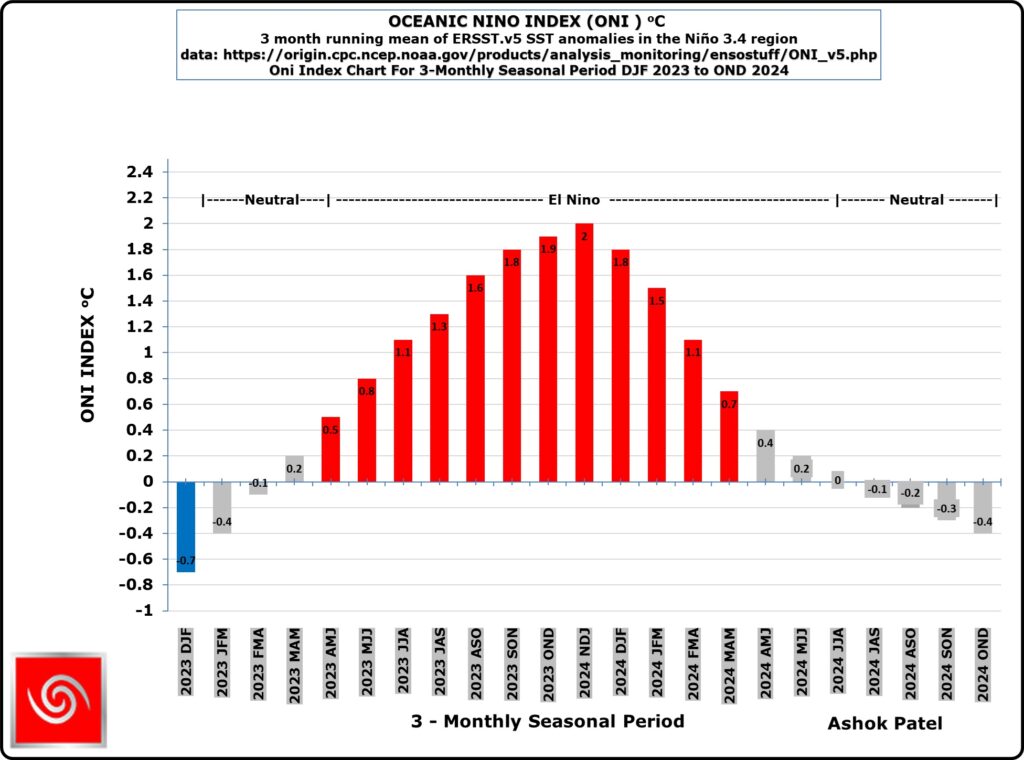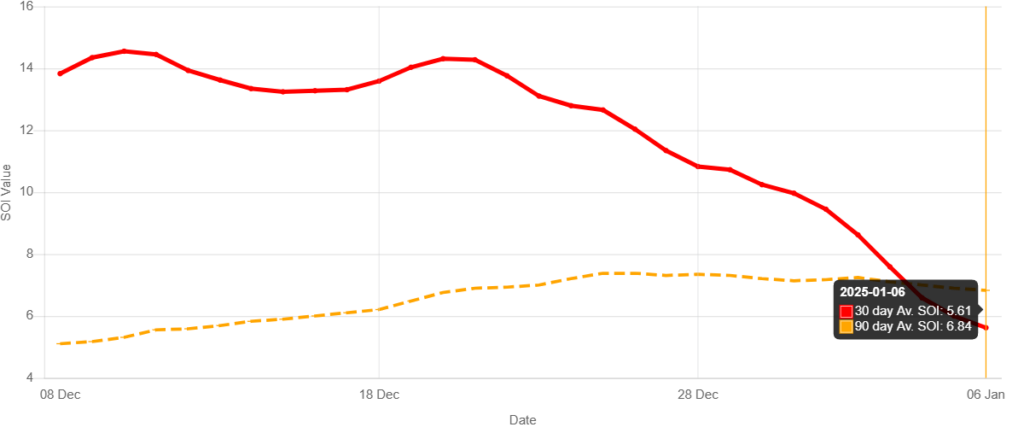ENSO Neutral Conditions Persist: Earliest Potential First La Niña Threshold Achievable By End of January 2025
Enso Status on 7th January 2025
Analysis & Commentary by Ashok Patel
Several international meteorological agencies, including the Indian Meteorological Department and various private meteorological organizations in India, had anticipated the development of a La Niña event during the Indian Summer Monsoon of 2024. The reality is that not a single La Nina thresh hold has been established till date. In fact we had taken a different stance and published monthly blog posts to provide a counter perspective, as summarized below:
5th July 2024
Title: “El Niño Ends & First ENSO Neutral Threshold Established End of June 2024 – Full-fledged La Niña As Per NOAA Criteria Not Expected During Indian Southwest Monsoon 2024” Available here
In our first post, we highlighted the end of the El Niño phase, with the ENSO conditions transitioning to neutral by the end of June. Based on NOAA criteria, we concluded that a full-fledged La Niña event was unlikely during the Indian Southwest Monsoon of 2024.
9th August 2024
Title: “NOAA Criteria Suggest Full-Fledged La Niña Unlikely in 2024 – Even a Single La Niña Threshold Unlikely During the Indian Southwest Monsoon” Available here
Our second update reiterated that, according to NOAA criteria, a full-fledged La Niña was unlikely in 2024. We further emphasized that even crossing a single La Niña threshold during the monsoon season seemed improbable.
6th September 2024
Title: “Much-Awaited La Niña Unlikely in 2024; La Niña Threshold Not Expected During Indian Southwest Monsoon”
Available here
By September, our analysis further confirmed that the much-anticipated La Niña event was unlikely to occur, with no indications of reaching the La Niña threshold during the Indian Southwest Monsoon.
23rd October 2024
Title: “La Niña Threshold Not Yet Reached: Full-fledged La Niña Unlikely During Indian Winter 2024-25” Available here
Our fourth update noted that as of September end, the La Niña threshold had still not been reached, suggesting that a full-fledged La Niña event during the Indian Winter of 2024-25 was also unlikely.
6th November 2024
Title: “La Niña Playing Hard Ball: Full-fledged La Niña Unlikely During Indian Winter 2024-25” Available here
Our fifth post reaffirmed that La Niña conditions were proving elusive. With no clear signals of a La Niña, we maintain that La Nina will not materialize during the Indian Winter 2024-25.
6th December 2024
Title: “ENSO Neutral Conditions Persist: La Niña Threshold Not Yet Reached, Full-fledged La Niña Requires At Least Five Months” Available here
Our sixth post we report that the La Niña threshold has not yet been reached, and we stress that a full-fledged La Niña would require at least five months of sustained La Nina thresh hold conditions once it is reached.
7th January 2025
Title: “ENSO Neutral Conditions Persists: Earliest Potential First La Niña Threshold Achievable End Of January 2025”
Our seventh post here we report that not a single La Niña threshold has been established, and even the first La Nina thresh hold is established at the end of January, we stress that a full-fledged La Niña would require at least five months of sustained La Nina thresh hold conditions if it is reached.
What is a Fully Developed La Niña?
To understand why the anticipated La Niña failed to materialize, it’s important to define what constitutes a “fully developed La Niña,” or a “full-fledged La Niña,” based on NOAA’s operational definitions for ENSO (El Niño-Southern Oscillation):
- El Niño is characterized by a positive Oceanic Niño Index (ONI) greater than or equal to +0.5ºC.
- La Niña is defined by a negative ONI less than or equal to -0.5ºC.
For an event to be classified as a full-fledged El Niño or La Niña, the respective ONI threshold must be exceeded for at least five consecutive overlapping 3-monthly seasons.
ONI Data has been obtained from CPC – NWS – NOAA available here
As of the end of December 2024, the Oceanic Niño Index (ONI) remains at -0.4°C, keeping the ENSO-neutral threshold intact for the OND (October-November-December) 2024 season. This marks the seventh consecutive ENSO-neutral condition. To transition into a La Niña state, the ONI thresh hold would need to drop to at least -0.5°C for the period NDJ season (November-December 2024-January 2025). Specifically, the combined Niño3.4 sea surface temperature (SST) for November, December 2024 and January 2025 must total at least -1.36°C.
Currently, the Niño3.4 SST is recorded at -0.25°C for November 2024 and -0.55°C for December 2024. To meet the necessary three-month total, the SST in January 2025 would need to be -0.56°C. If this occurs, the first La Niña threshold would be met for the NDJ 2025 season, potentially setting the stage for a fully developed La Niña by May 2025, provided the La Niña thresholds are sustained across all overlapping three-monthly seasons until then.
Based on this analysis and NOAA criteria, a fully developed La Niña is unlikely unless the La Niña threshold is first established and then sustained over four more consecutive seasons. It is also possible that if the first La Niña threshold is established, it may only be exceeded for a total period of four or fewer consecutive overlapping three-month seasons, which, historically, would still be considered ENSO-neutral.
How ONI is determined:
The ONI is based on SST departures from average in the Niño 3.4 region, and is a principal measure for monitoring, assessing, and predicting ENSO. Defined as the three-month running-mean SST departures in the Niño 3.4 region. Departures are based on a set of improved homogeneous historical SST analyses (Extended Reconstructed SST – ERSST.v5).
In real-time operations, the past 30-year base period (e.g. 1991–2020) will continue to be used to compute the departure from average. However, CPC will create an additional 30-year base period every 5 years (the next update will be at the beginning of 2026). When these 5 year updates occur, the ONI values over the most recent decade will change slightly because of the inclusion of more recent data. Every five years, this method takes care of climatological changes in the SST of Nino3.4 region and the buzz about the need to adopt Relative Nino Index is not justified.
NOAA Operational Definitions for El Niño and La Niña, El Niño: characterized by a positive ONI greater than or equal to +0.5ºC. La Niña: characterized by a negative ONI less than or equal to -0.5ºC. By historical standards, to be classified as a full-fledged El Niño or La Niña episode, these thresholds must be exceeded for a period of at least 5 consecutive overlapping 3-month seasons.
CPC considers El Niño or La Niña conditions to occur when the monthly Niño3.4 OISST departures meet or exceed +/- 0.5ºC along with consistent atmospheric features. These anomalies must also be forecast to persist for 3 consecutive months.
The Climate Prediction Center (CPC) is a United States Federal Agency that is one of the NECP, which are a part of the NOAA
Latest Oceanic Nino Index Graph Shows Enso Neutral
Conditions Prevail At The End Of December 2024
The Table below shows the monthly SST of Nino3.4 Region and the Climate adjusted normal SST and SST anomaly from February 2023. Climate Base 1991-2020. ERSST.v5
Period Nino3.4 ClimAdjust YR MON Temp.ºC Temp.ºC ANOM ºC 2023 2 26.30 26.76 -0.46 2023 3 27.19 27.29 -0.11 2023 4 27.96 27.83 0.14 2023 5 28.40 27.94 0.46 2023 6 28.57 27.73 0.84 2023 7 28.31 27.29 1.02 2023 8 28.21 26.86 1.35 2023 9 28.32 26.72 1.60 2023 10 28.44 26.72 1.72 2023 11 28.72 26.70 2.02 2023 12 28.63 26.60 2.02 2024 1 28.37 26.55 1.82 2024 2 28.28 26.76 1.52 2024 3 28.42 27.29 1.12 2024 4 28.60 27.83 0.78 2024 5 28.17 27.94 0.24 2024 6 27.91 27.73 0.18 2024 6 27.90 27.73 0.17 2024 7 27.34 27.29 0.05 2024 8 26.74 26.86 -0.12 2024 9 26.46 26.72 -0.26 2024 10 26.45 26.72 -0.27 2024 11 26.46 26.70 -0.25 2024 12 26.05 26.60 -0.55
Indications and analysis of various International Weather/Climate agencies monitoring Enso conditions is depicted hereunder:
Summary by: Climate Prediction Center / NCEP Dated 30th December 2024
ENSO Alert System Status: La Niña Watch
ENSO-neutral conditions are present.*
Equatorial sea surface temperatures (SSTs) are near-to-below average in the central and eastern Pacific Ocean.
La Niña conditions are most likely to emerge in November 2024 – January 2025 (59% chance), with a transition to ENSO-neutral most likely by March-May 2025.*
Note: Statements are updated once a month (2nd Thursday of each month) in association with the ENSO Diagnostics Discussion, which can be found by clicking here.
Recent (preliminary) Southern Oscillation Index values as per The Long Paddock – Queensland Government.
The 30 Days average SOI for end of December was in the positive zone at 9.72, however, on 6th January 2025 it has decreased and entered neutral zone at +5.61 as per The Long Paddock – Queensland Government. The 90 Days average SOI was +6.84 on 6th January 2025.
As per BOM – Australia 24th December 2024
- The El Niño–Southern Oscillation (ENSO) is currently in the neutral range. Since November, atmospheric indices such as the SOI and trade winds have strengthened towards La Niña with oceanic indices responding in recent weeks.
- Some oceanic and atmospheric patterns in the Pacific have at times shown weak La Niña characteristics in 2024 but with little coupling. For an event to become established, both atmospheric and oceanic indices would need to be sustained at La Niña levels for at least 3 months.
- The Bureau’s model forecasts that SSTs in the central tropical Pacific will remain in the ENSO-neutral range throughout the forecast period to April 2025, despite briefly dipping below the La Niña threshold in January. This is consistent with 4 of the 6 other international climate models surveyed.

